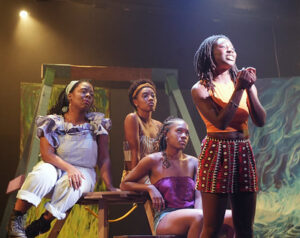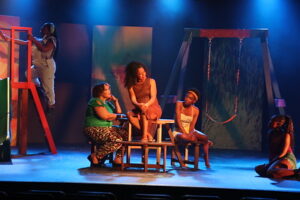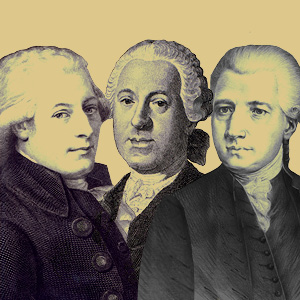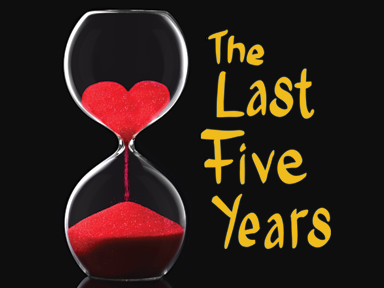
 **** “For Colored Girls Who Have Considered Suicide/When the Rainbow is Enuf” was originally penned in 1976 by Ntozake Shange. This is a set of twenty “choreopoems” which were inspired by instances leading to suicidal thoughts in Shange’s own life. These combinations of poems, dances, songs, and stories with music reflect the pain of existence, particularly having to do with the existential situation of being both female and black. When seeing a double rainbow helped to dispel Shange’s despair about the trajectory of her life, she became inspired to write this play. The colors of the rainbow subsequently become the seven unnamed characters in the story, each of whom describes Shange’s own experiences with violence and sexual abuse. The playwright shows us that when women of color are being viciously attacked, raped, beaten, demeaned, and berated by husbands and lovers, they often very have little recourse. The performance demonstrates that each of the women must find the strength within themselves to overcome the psychological and physical damage caused by intimate partners and rapists. Survival is key when swimming against a crushing tidal wave of male dominance and oppression, which filters down from the societal to the individual level in our culture. While the next generation of girls might experience the same situation, knowledge of this vicious cycle might hopefully change things for the better. The production currently being featured at the Fleetwood-Jourdain Theatre and deftly directed by Tim Rhoze is taken from Shange’s updated version of the script from 2010. It was then that she added the poem “positive” to the play, plus she indicated that women can and do get AIDS, and she referenced the Iraq War and PTSD.
**** “For Colored Girls Who Have Considered Suicide/When the Rainbow is Enuf” was originally penned in 1976 by Ntozake Shange. This is a set of twenty “choreopoems” which were inspired by instances leading to suicidal thoughts in Shange’s own life. These combinations of poems, dances, songs, and stories with music reflect the pain of existence, particularly having to do with the existential situation of being both female and black. When seeing a double rainbow helped to dispel Shange’s despair about the trajectory of her life, she became inspired to write this play. The colors of the rainbow subsequently become the seven unnamed characters in the story, each of whom describes Shange’s own experiences with violence and sexual abuse. The playwright shows us that when women of color are being viciously attacked, raped, beaten, demeaned, and berated by husbands and lovers, they often very have little recourse. The performance demonstrates that each of the women must find the strength within themselves to overcome the psychological and physical damage caused by intimate partners and rapists. Survival is key when swimming against a crushing tidal wave of male dominance and oppression, which filters down from the societal to the individual level in our culture. While the next generation of girls might experience the same situation, knowledge of this vicious cycle might hopefully change things for the better. The production currently being featured at the Fleetwood-Jourdain Theatre and deftly directed by Tim Rhoze is taken from Shange’s updated version of the script from 2010. It was then that she added the poem “positive” to the play, plus she indicated that women can and do get AIDS, and she referenced the Iraq War and PTSD.
The show goes through the life cycle of several black women, from the time they are young girls happily skipping around and playing games through the moment of their (natural) death. We see how race, culture, and violent circumstances intersect as we witness how women from different walks of life constantly struggle to survive as they grow and mature. This is well depicted visually by the set designers, Shane Rogers and Tim Rhoze, who have re-created playground equipment on stage. Initially see little girls play on the slide, teeter-tauter, and swing. But later, in a dark turn, these objects mimic instruments of sexual torture. With their innocence no more, these women of color are debased into “colored girls”, a term intentionally used in the title and at the beginning and end of the show to describe their diminished self-worth sometimes in their own eyes. Eventually, however, these unnamed women succeed in life by choosing not to commit suicide despite all of the ills which have befallen them. What we gain from watching this performance is a sense of who these various women are, where they come from, and what they are going through as they constantly work to overcome personal obstacles and succeed against all odds.
Cast members include: Angelena Browne, Ashli Rene Funches, Candice Jeanine, Nehanda Julot, Tuesdai B. Perry, Jazzma Pryor, and Jenise Sheppard. Choreography by Marsae Lynette Mitchell is nicely done, with rhythmic dancing on the part of all of the characters. This adds energy to the performance. using different colors of lights, Levi Wilkins has neatly demarcated scenes and created important moods, which add to the drama. Costume designer Kate Parker Barrows has created appropriate outfits befitting the modern era, and sound designer Rick Sims has done respectable work in making this production happen.
When we first walk into the theatre, we cannot help but notice the seven separate artist’s panels by Sam Onche. Extraordinarily well-executed, these murals make a huge statement and enhance the theme of this show! Each canvas depicts one of the colors of the rainbow, and they are hung in sequence behind the stage from red to purple. While the red one on stage right is very beguiling, I particularly liked the green one right behind the swing, giving the scene an outdoor feel. But it’s the series of them hanging together that creates a spectacle.
You can tell that the script was not written today, but this does not make it any less relevant. In 2024, the play would have probably included discussions about shootings and would have contained more up-to-date political references and some different music. But this show is not a historical piece nor meant to be. My point is that the story is just as relevant now as it was when it was first written. This is a sad commentary on the nature of domestic violence and abuse as told in a story that is almost as old as time itself. In all, despite some moments of humor and gaiety and the women’s desire for love and romance and wanting to lead a good family life, this is a depressing and painful tale. Yet it’s told very well, and the cast does a marvelous job inhabiting the characters of these abused and maltreated women who must dig deep inside of themselves to develop strength and self-confidence.
“For Colored Girls Who Have Considered Suicide/When the Rainbow is Enuf” is playing through August 4, 2024, at the Fleetwood-Jourdain Theatre in the Noyes Cultural Arts Center, 927 Noyes Street, Evanston.
Tickets are: $32.
Additionally, 2024 Premium Gold Member Cards, good for all three 2024 summer and fall play productions and the summertime concert, are now on sale for a very limited time for only $100 – saving a total of $30 off the regular season ticket price.
 Performance schedule:
Performance schedule:
Saturdays at 7:00 p.m.
Sundays at 3:00 p.m.
For more information, go to: https://www.cityofevanston.org/about-evanston/arts-and-culture/theatre/fleetwood-jourdain-theatre.
To purchase tickets, visit:
https://apps.cityofevanston.org/webtrac/wbwsc/webtrac.wsc/search.html?display=detail&module=PST&_csrf_token=807179b1630cd42852e480019bdcde282c8327b489befddc12e01f5ae233f568.
To see what others are saying, visit www.theatreinchicago.com, go to Review Round-Up and click at ” For Colored Girls Who Have Considered Suicide/When The Rainbow is Enuf”.






More Stories
“The Firebugs” reviewed by Julia W. Rath
“The Book of Grace”
“The Last Five Years” MILWAUKEE